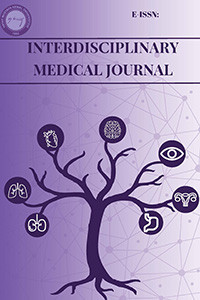Prognosis and risk factors of chronicity in childhood idiopathic thrombocytopenic purpura: a single-center experience
Prognosis and risk factors of chronicity in childhood idiopathic thrombocytopenic purpura: a single-center experience
Idiopathic Thrombocytopenic Purpura Chronic, Children,
___
- Miltiadous O, Hou M, Bussel J.B. Identifying and treating refractory ITP: difficulty in diagnosis and role of combination treatment. Blood. 2020;135(7):472-490. https://doi.org/ 10.1182/blood.2019003599. Bennett CM, Neunert C, Grace RF, Buchanan G, Imbach P, Vesely SK, et al. Predictors of remission in children with newly diagnosed immune thrombocytopenia: Data from the Intercontinental Cooperative ITP Study Group Registry II participants. Pediatr Blood Cancer. 2018;65(1). https://doi.org/10.1002/pbc.26736.
- Jaime-Pérez JC, Aguilar-Calderón P, Jiménez-Castillo RA, Ramos-Dávila EM, Salazar-Cavazos L, Gómez-Almaguer D. Treatment outcomes and chronicity predictors for primary immune thrombocytopenia: 10-year data from an academic center. Ann Hematol. 2020;99(11):2513-2520. https://doi.org/10.1007/s00277-020-04257-2.
- Fernández-Plaza S, González de Pablo J, Gálvez E, Zubicaray J, Guillén M, Sevilla J, et al. Variables related to chronic immune thrombocytopenia: experience from a single center and comparison to a meta-analysis. Eur J Pediatr. 2021;180(7):2075-2081. https://doi.org/10.1007/s00431-021-03990-8.
- Glanz J, France E, Xu S, Hayes T, Hambidge S. A population-based, multisite cohort study of the predictors of chronic idiopathic thrombocytopenic purpura in children. Pediatrics. 2008;121: e506–e512 https://doi.org/10.1542/peds.2007-1129.
- Bruin M, Bearings M, Uiterwaal C, Révész T, Bode L, Wiesman ME et al. Platelet count, previous infection and FCGR2B genotype predict development of chronic disease in newly diagnosed idiopathic thrombocytopenia in childhood: results of a prospective study. Br J Haematol. 2004; 127:561–567. https://doi.org/10.1111/j.1365-2141.2004.05235
- Heitink-Pollé KM, Nijsten J, Boonacker CW, de Haas M, Bruin MC. Clinical and laboratory predictors of chronic immune thrombocytopenia in children: a systematic review and meta-analysis. Blood. 2014; 124:3295–3307. https://doi.org/10.1182/blood-2014-04-570127.
- Emilia Parodi, Giovanna Russo, Piero Farruggia, Lucia D Notarangelo, Maria T Giraudo, Margherita Nardi, “AIEOP-ITP Study Group”. Management strategies for newly diagnosed immune thrombocytopenia in Italian AIEOP Centres: do we overtreat? Data from a multicentre, prospective cohort study. Blood Transfus 2020;18(5):396-405. https://doi.org/10.2450/2020.0041-20.
- Tamminga R, Berchtold W, Bruin M, Buchanan GR, Kühne T. Possible lower rate of chronic ITP after IVIG for acute childhood ITP an analysis from registry I of the Intercontinental Cooperative ITP Study Group (ICIS). Br J Haematol 2009; 146:180–184. https://doi.org/10.1111/j.1365-2141.2009.07743.x.
- Heitink-Pollé KMJ, Uiterwaal CSPM, Porcelijn L, Tamminga RYJ, Smiers FJ, van Woerden N, et al. Investigators Intravenous immunoglobulin versus observation in childhood immune thrombocytopenia: a randomized controlled trial. Blood 2018;132: 883–891. https://doi.org/10.1182/blood-2018-02-830844.
- Neunert C, Terrell DR, Arnold DM, Buchanan G, Cines DB, Cooper N, Cuker A, Despotovic JM, George JN, Grace RF, Kühne T, Kuter DJ, Lim W, McCrae KR, Pruitt B, Shimanek H, Vesely SK. American Society of Hematology 2019 guidelines for immune thrombocytopenia. Blood Adv. 2019 Dec 10;3(23):3829-3866. https://doi: 10.1182/bloodadvances.2019000966.
- Donato H, Picón A, Rapetti MC, Rosso A, Schvartzman G, Drozdowski C, Di Santo JJ. Splenectomy and spontaneous remission in children with chronic idiopathic thrombocytopenic purpura. Pediatr Blood Cancer. 2006 Oct 15;47(5 Suppl):737-9. https://doi: 10.1002/pbc.20982.
- Deel M, Kong M, Cross K, Bertolone S. Absolute lymphocyte counts as prognostic indicators for immune thrombocytopenia outcomes in children. Pediatr Blood Cancer 2013; 60:1967–1974. https://doi.org/10.1002/pbc.24628.
- Ahmed I, Rajpurkar M, Thomas R, Chitlur M. Initial lymphocyte count and the development of persistent/chronic immune thrombocytopenic purpura. Pediatr Blood Cancer. 2010; 55:508–511. https://doi.org/10.1002/pbc.22570.
- Demircioglu F, Saygi M, Yilmaz S, Oren H, Irken G. Clinical features, treatment responses, and outcome of children with idiopathic thrombocytopenic purpura. Pediatr Hematol Oncol. 2009;26(7):526–532. https://doi.org 10.108/ 08880010903044540.
- Grace RF, Despotovic JM, Bennett CM, Bussel JB, Neier M, Neunert C, Crary SE, Pastore YD, Klaassen RJ, Rothman JA, Hege K, Breakey VR, Rose MJ, Shimano KA, Buchanan GR, Geddis A, Haley KM, Lorenzana A, Thompson A, Jeng M, Neufeld EJ, Brown T, Forbes PW, Lambert MP. Physician decision making in selection of second-line treatments in immune thrombocytopenia in children. Am J Hematol. 2018;93(7):882-888. https://doi: 10.1002/ajh.25110.
- Yayın Aralığı: Yılda 3 Sayı
- Başlangıç: 2023
- Yayıncı: Hatay Mustafa Kemal Üniversitesi Tıp Fakültesi Dekanlığı
Hatice Mine ÇAKMAK, Kenan KOCABAY
Hacer DEMİRKÖSE, Furkan AKYÜZ, Mehmet Enes GÖKLER
Ömer Faruk TEKİN, Müberra ÇAKICI TOSUN
The effect of Covid-19 anxiety on prenatal distress and prenatal attachment in pregnant women
Dilay KARADEMİR, Ezgi AĞADAYI, Seher KARAHAN
Monocyte eosinophil ratio and red blood cell distribution width in the diagnosis of asthma
Breast cancer and the molecular mechanism of estrogen signaling
Yalçın ERZURUMLU, Hatice Kübra DOĞAN
Mehmet Cenk BELİBAĞLI, Nilüfer AYGÜN BİLECİK
The role of surgery in perianal disease developing in hematology malignancy patients
Serkan ERKAN, Ramazan GÜNDOĞDU, Murat KUŞ, Hakan YABANOĞLU
Evaluation of serum adipocytokine and interleukin-18 levels in patients with epilepsy
Ahmet DÜNDAR, Derya KILINÇ, Ahmet YILMAZ, Vugar JAFAR, Orhan AYAN, Mehmet Uğur ÇEVİK, Hamza ASLANHAN
Özlem NALBANTOĞLU, Semra GÜRSOY, Tarık KIRKGÖZ, Filiz HAZAN, Behzat ÖZKAN
